Article's Content
If you search for “best legal software for small law firms” on Google today, you won’t just get 10 blue links.
Instead, an AI-written overview will explain your options, compare tools, and keep mentioning the same brand — Clio.
Clio is a vertical SaaS platform for law firms, but it’s also something else: a live case study in how a decade of smart organic marketing can turn into outsized visibility in AI Overviews, ChatGPT, Perplexity, and beyond.
Today, we’ll take a look at how Google’s AI Overviews are changing the rules, how Clio ended up on the winning side of that shift, and what you can steal from their playbook for your own Generative Engine Optimization (GEO) program.
The Impact of Google’s AI Overview
Google officially announced their Gemini-powered AI Overviews (AIOs) at I/O just 18 months ago. They positioned it as a great benefit for time-strapped users:
“Sometimes you want a quick answer, but you don’t have time to piece together all the information you need. Search will do the work for you with AI Overviews.” – Elizabeth Reid, Google VP, Search, May 2024
AIOs combine Google’s search engine with its LLM capabilities to answer search queries based on the content indexed on the topic. Instead of a Featured Snippet, People Also Ask and a list of top-ranking URLs, the AI Overviews include a sort of mini-blog post with its own mini-SERP.
For instance, the query “best software for small legal team” produces:
- Two short paragraphs outlining what to look for and naming brands like Clio, MyCase, and PracticePanther
- A table chart comparing the best use cases, key features, and pricing model of the leading platforms
- A list of the 13 web pages used as source material for the LLM-generated response
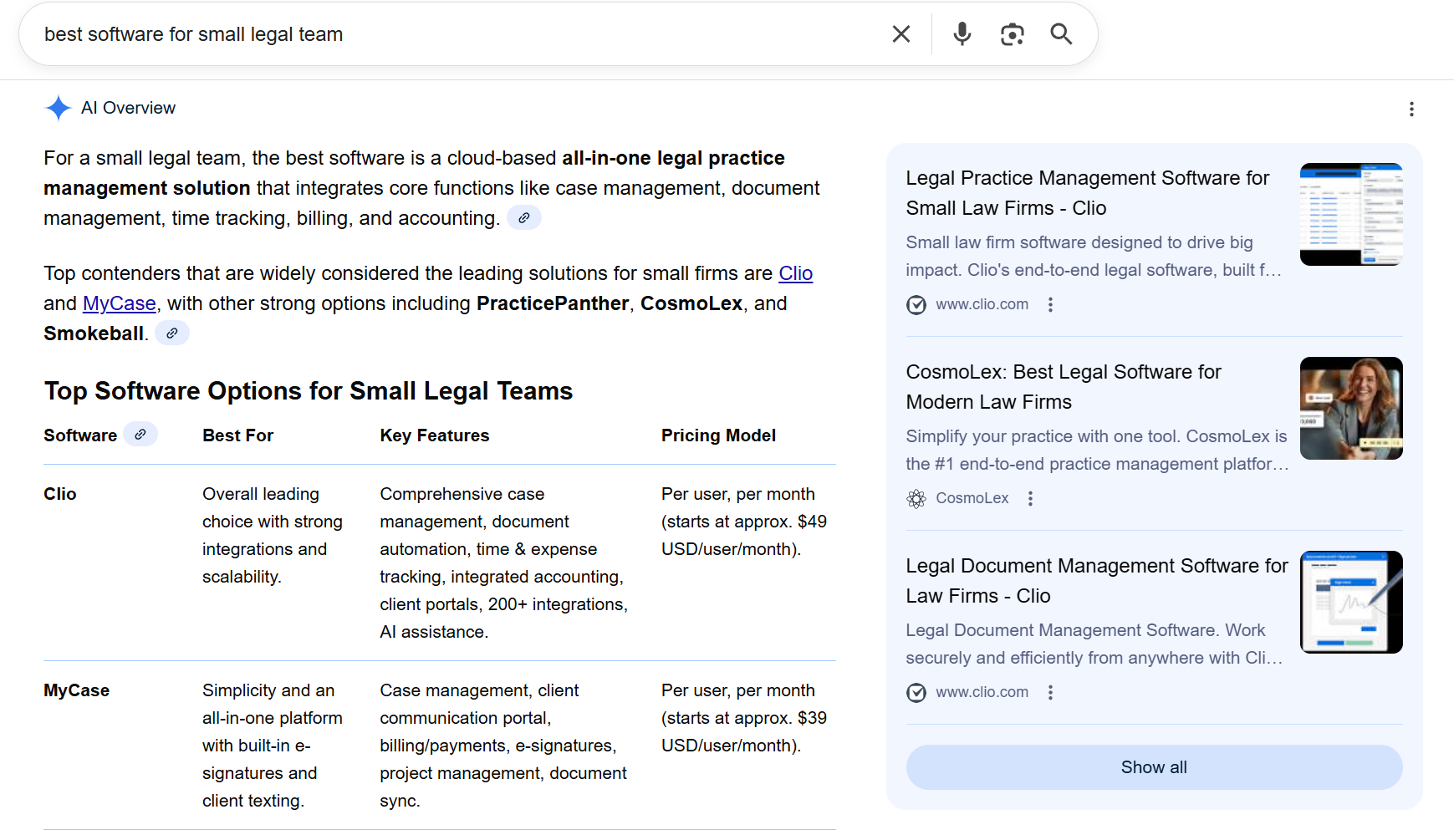
According to Ahrefs analysis of 146 million SERPs, 21% of all queries triggered the AI Overview feature. And as Ryan Law notes, “most websites can expect to compete with a Google-branded AI-generated blog post for 1 in every 5 of the keywords they target.”
AIOs may be positioned as a convenience feature for users, but they carry significant implications for any business that depends on organic search. With AIOs taking over informational intent, brands are left asking a critical question:
Do AI Overviews help or hurt your brand?
Google claims they will lead to more clicks. Pew’s early data suggests the opposite. And marketers are increasingly worried about what this shift means for traffic, leads, and the top of the funnel.
The Bad: AIOs Reduce Organic and Paid Clicks
Pew Research compared the behaviour of 900 web searches across over 68,000 browsing sessions for SERPs with and without AI summaries. They found that:
- Only 8% of users click on a traditional search result if an AIO is present, down from 15% when there’s no AI summary.
- Just 1% of users click on links that appear inside the AI summary.
- Users who encounter an AIO are more likely to end their browsing session entirely (26%) than those who don’t (16%).
Interestingly, another Pew analysis of search behaviour reported that the majority of adults find at least some value in AI SERP summaries, and 20% thought they were extremely/very useful.
But, though users find them useful, the picture is a lot less clear for brands and businesses.
The team at Seer Interactive analyzed 25 million SERP impressions from June 2024 through September 2025 and found a notable gap between AIO and non-AIO query performance.
In September 2025, queries with AI Overviews showed an organic click-through rate (CTR) of just 0.61% compared to 1.62% without them — a 166% difference. Paid CTR showed an even starker contrast: 6.34% for AIO queries versus 13.04% for non-AIO ones.
Interestingly, CTRs are declining across the board: even non-AIO queries dropped 41% year-over-year in their analysis. But the case remains that queries that trigger an AIO consistently underperform those that don’t.
Whether AIOs directly cause this gap or simply appear in query types that were already low-click (Seer’s hypothesis), remains an open question. Still, the correlation is clear: when an AIO is present, fewer people click.

This data doesn’t bode well for the traditional funnel view of inbound marketing, where brands capture top-of-funnel traffic through pages targeting informational keywords. That said, there’s still opportunity in this, especially considering how long the B2B buyer journey has become.
Recent data on the impact of AIOs isn’t promising for marketers, but there is a silver lining.
The Good: Cited Brands Win Big
There’s a silver lining to the Seer research: when a brand is cited inside an AI Overview, CTR performance is dramatically better than brands that get left out:
- 35% higher organic CTR on AIO queries when you’re cited vs not cited
- 91% higher paid CTR in those same situations
Looking back to Ahrefs’ recent research reinforces how high the stakes are: if one out of five queries now includes an AI Overview, then your probability of showing up in them is a key part of your SEO moat.
Click-through rates aside, there’s also a brand impact to AI mentions and citations. In Ross Simmonds’ words: “If your company isn’t one of the handful of trusted sources AI keeps surfacing, you’re invisible in this new search ecosystem.”
This visibility advantage is not accidental.
The brands that appear consistently in AIOs are the ones that already show strong authority across content, social media, Reddit, and broader brand marketing. These signals reduce the impact of zero-click searches and increase the likelihood that AI systems will cite and recommend the brand.
Most companies lose traffic in AIO-dominated SERPs, but category leaders that meet these authority signals — like Clio in the legal tech vertical — gain disproportionate visibility.
Clio’s Outsized Wins in a Zero-Click World
Even as CTRs fall across informational queries, Clio’s holistic performance is not collapsing.
According to Web traffic data from SimilarWeb, Clio had over 6.5 million visitors last month — a 1.44% increase month-over-month. Clio’s strong brand is the main traffic driver, with over three-quarters of that traffic coming via direct search. Organic search is the next most popular, bringing in 18% of their total web traffic.
Clio has already built a brand strong enough that lawyers go straight to them. The combination of strong brand presence, an extensive content library, and heavy AIO citations is what allows Clio to win while others lose traffic.
Their visibility in AI search is no fluke. It’s the result of how their content is structured and how much trustworthy information they’ve published over the years. AI systems rely on that depth, which is why Clio surfaces so often.
The Not So Secret Strategy Fueling Clio’s AI Visibility
Their edge starts with the fundamentals, and content is the first place it shows.
Consistent, Compounding Investment in SEO Content
Naturally, Clio didn’t set out in 2008 saying, “Let’s optimize for AI Overviews.”
What they did was spend years building the informational content that their audience, search engines, and now AI models can trust. Here’s a look at the current asset allocation of the Clio domain and how each impacts organic performance:
- Blog (555 URLs): Provides comprehensive, long-form educational content — legal how-tos, marketing advice, definitions, and trend analyses — that align perfectly with the informational and question-based queries AI Overviews most often summarize.
- Resources (383 URLs): Offer structured, evergreen legal templates, guides, toolkits, and calculators that give LLMs clear, authoritative material to synthesize into step-by-step answers.
- Localized Sites (UK/AU/CA/IE) (387 URLs): Deliver jurisdiction-specific legal explanations and practice guidance that help AI match answers to local legal contexts with high confidence.
- Practice Area Pages & Legal Definitions (dozens): Break down legal concepts, workflows, and specialty-specific knowledge into concise, high-clarity explanations that map directly to “what is” and “how does” queries favoured by AI Overviews.
- Features + Product Pages (50+): Present authoritative descriptions of legal software tools and workflows that AI Overviews rely on when summarizing legal tech solutions and software recommendations.

Many B2B brands use a similar content mix to drive organic growth. For example, NinjaOne published over 900 pages of blog content in the last year. This approach is a staple of SEO and aligns perfectly with Ross’ GEO framework: “AI tools don’t reward mystery or fluff. They reward content that’s clear, structured, and gives direct answers upfront.”
Clio built that kind of content long before GEO had a name.
Building Brand Authority in Search and Beyond
On top of content marketing and SEO prowess, Clio brings serious domain-level authority to the table:
- Domain Rating 85, 13.1K referring domains, 535K backlinks (Ahrefs Domain Overview, 2025).
- Links from heavyweight institutions like the Law Society of Scotland, Irish Law Society, and multiple state bar associations.
They’re also investing in content and brand presence across YouTube, LinkedIn, Facebook, Reddit, and other UGC platforms where AI pulls context.
From a GEO lens, that’s textbook “build authority signals AI trusts”:
- Clear ownership and authorship signals
- Lots of third-party validation
- Original research and benchmarks
SEO and GEO are closer than they appear, and Clio spent a decade doing the groundwork Ross outlines in his GEO roadmap: audit → structure → authority. That foundation shows up clearly when you look at which Clio pages AI systems choose to cite.
The Clio Content Showing Up in Google’s AI Overviews
Clio doesn’t appear everywhere in AIOs by chance. AI systems pull from specific types of content, and Clio’s library happens to match those patterns exceptionally well. A closer look at their cited pages shows what AI considers high-value material.
Tofu Content Dominates Clio’s AI Overview Citations
If you look at which Clio subfolders show up most often in AIO citations, one pattern jumps out: top-of-funnel, informational content dominates.
Here’s what it looks like when we map AIO-cited URLs by subfolder and topic:
- Blog – 34.6%
- Resources – 24.8%
- Localized content (UK/CA/AU/IE) – ~20%
- Help Center – 5.3%
- Features – 2.5%
- App Directory – 2.1%
- Forms – 1.35%
- Practice Types – 1.26%
So, Clio blog posts targeting queries like “digital marketing for lawyers” or “how to build a law firm website,” provide the raw material for AI answers.
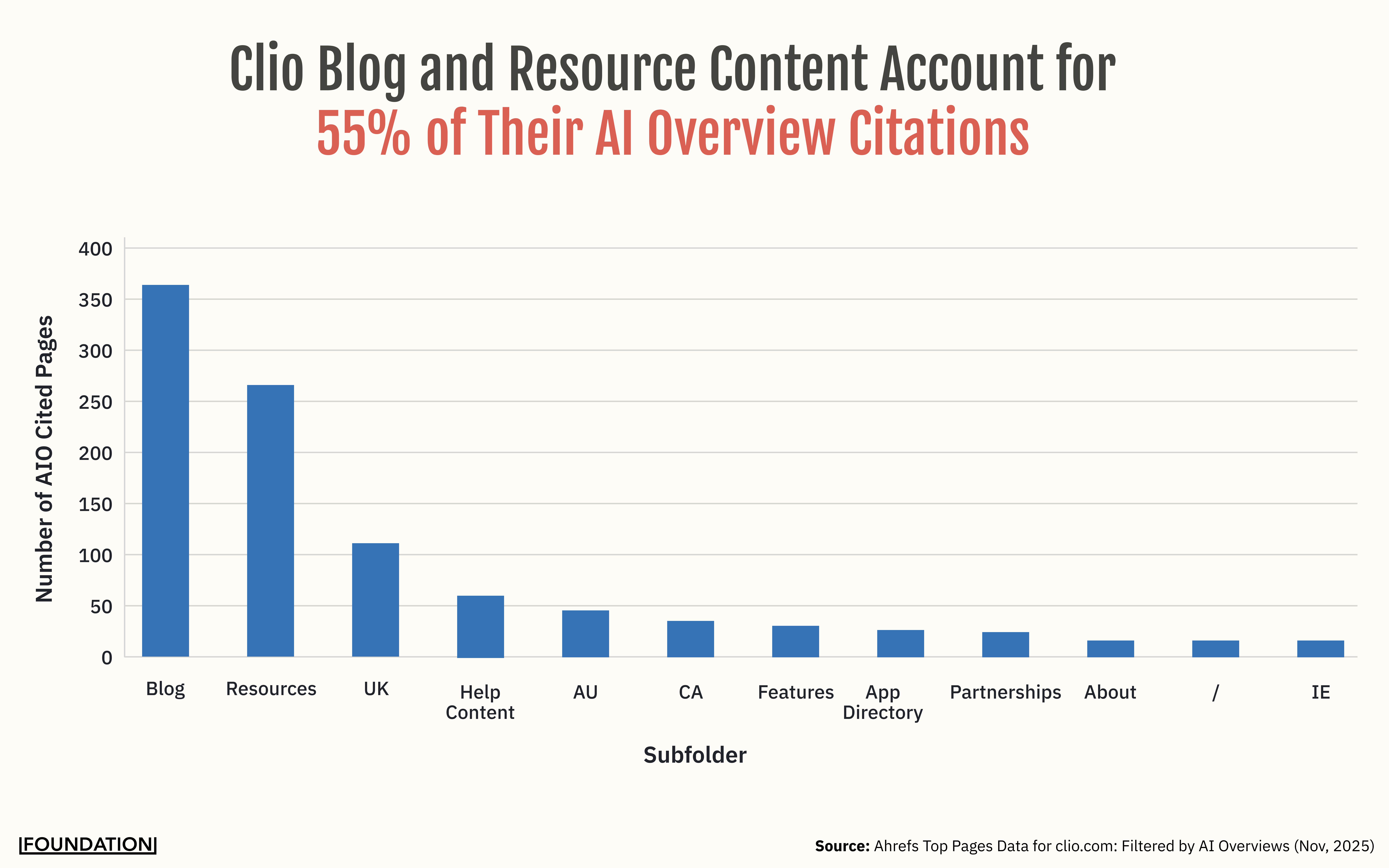
This lines up perfectly with broader AIO patterns: Ahrefs found that AIOs are heavily biased toward top-of-funnel informational queries, not transactional or shopping terms. Semrush data backs up this assertion, with 88.1% of AIOs in their analysis triggered by informational searches.
This distribution makes more sense once you look at the kinds of queries that tend to trigger AIOs in the first place.
Why These Asset Types Dominate AIO Citations
During their analysis of millions of SERPs, Ahrefs also looked at how keywords are structured, and found that certain query types frequently trigger AIOs. Specifically, definition queries trigger AIOs 47.3% of the time, instructional (“how to”) queries trigger them 35.1% of the time, and reason (“why”) queries have the highest rate, triggering AIOs 59.8% of the time.
Clio’s content covers these kinds of questions in depth. For example, topics like “What does a personal injury lawyer do?” combine definition with explanation, “Best law firm websites” blends comparison with instruction, and “Digital marketing for lawyers” is structured as a multi-step how-to guide.
Their TOFU blogs usually:
- State the answer clearly in the first few lines
- Break supporting points into structured H2s and H3s
- Include examples, charts, or checklists
- End with FAQs or additional clarifications
Again, Clio’s approach aligns with Ross’s: “Start each page with a short answer, explain why it matters, and then back it up with data and examples… AI instantly knows what your page is about and can cite it with confidence.”
AI Overview Example: “Case management software”
Let’s examine how Clio dominates search results for one of the most valuable keywords in legal tech: “case management software.”
When this query triggers an AI Overview, Clio achieves something remarkable: full SERP dominance. They’re the first company mentioned in the AI summary, linked to in the AI Overview sources (though not as a top 3 link), and they rank in the first organic spot beneath the AIO.
They also hold the top sponsored position — complete control of the SERP real estate and features.
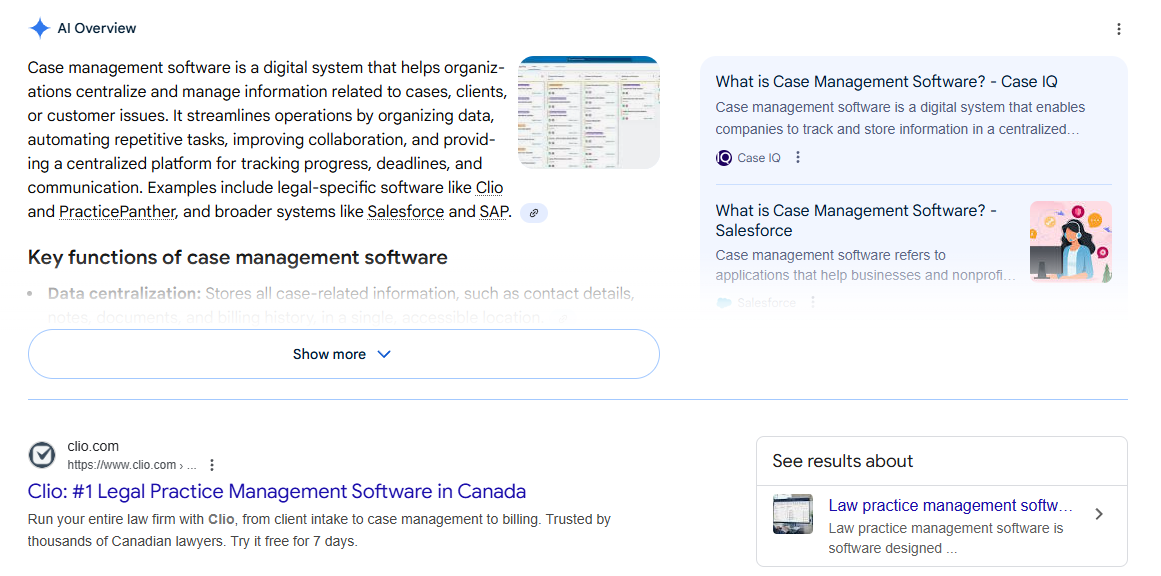
This multi-feature dominance carries significant brand implications. When a potential customer searches for “case management software,” they encounter Clio at every touchpoint: in the AI-generated answer explaining their options, in the organic results, and in the paid placements.
This repetition builds trust and positions Clio as the category leader before the searcher even clicks a single link.
AI Overviews favour content that is clear, structured, and immediately useful. Clio’s pages match that pattern better than anyone in their category, which is why they dominate AIO citations and SERP visibility. And that advantage doesn’t stop at Google.
How Clio Shows Up Across Leading AI Platforms
While Clio is cited heavily in Google’s AI Overview, their visibility extends across a number of leading LLMs.
Looking at mention and citation performance across different AI platforms, the results were consistently impressive — demonstrating how strong SEO authority translates into AI recommendations across the entire ecosystem.

Perplexity
When I asked Perplexity “What is the best case management platform for a mid-sized law firm in the UK?”, Clio was the top platform recommended.
The AI highlighted several key strengths:
- A major cloud-based case management system, frequently rated top in the small-to-mid-sized firm space
- Offers robust matter management, billing, client portal, and remote access
- International vendor (Canada/US originally) but has UK presence and localisation
Perplexity gives you visibility into the sources it used to determine its answer.
Interestingly, Clio received this prominent mention despite the sources being almost exclusively review sites — demonstrating how strong brand authority translates into AI recommendations even when the AI is synthesizing third-party perspectives rather than citing Clio’s own content directly.
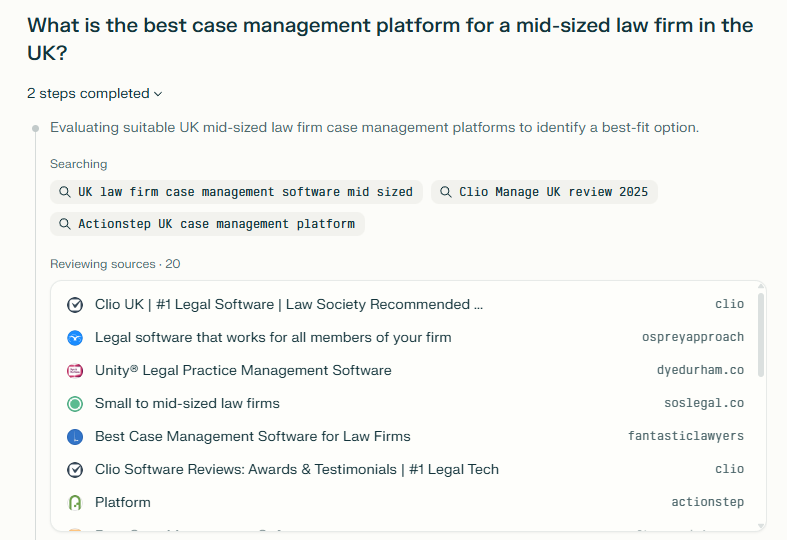
Overall, Clio earned 400 citations across 188 pages on Perplexity, making it one of the most-cited legal tech brands on the platform.
ChatGPT
ChatGPT similarly recommends Clio when asked about legal practice management software. The platform cites Clio as a comprehensive solution for law firms, drawing on examples, definitions, and legal procedural breakdowns from Clio’s content library.

Ahrefs data shows 196 citations across 192 pages on ChatGPT. What’s notable here is the nearly 1:1 ratio of citations to pages — suggesting that ChatGPT is drawing from a wide variety of Clio’s content rather than repeatedly citing the same few pages.
Gemini and Copilot
The pattern continues across other AI platforms. Gemini has cited Clio 178 times across 263 pages, while Copilot shows 112 citations across 70 pages. This cross-platform presence multiplies brand equity — even when clicks don’t occur, every AI mention reinforces Clio’s category leadership.
AI Search is a Key Driver of Clio Referral Traffic
Beyond citations, Clio is capturing traffic from AI platforms. According to SimilarWeb data from October 2025, their top referring websites tell an interesting story: ChatGPT is the top source (39.9%) and Perplexity brings in around 8%.
- ChatGPT.com – 39.9%
- Perplexity.ai – 7.99%
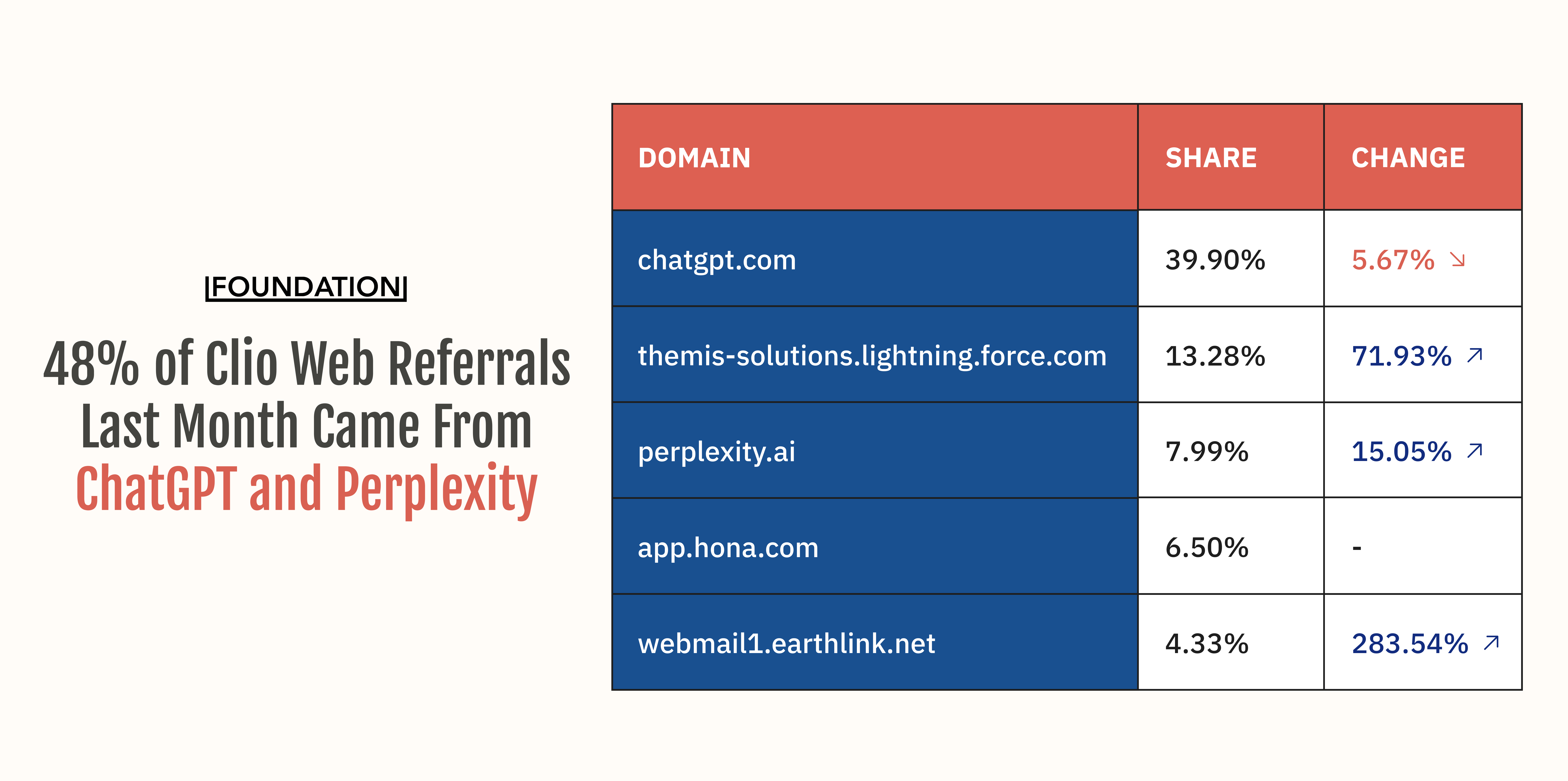
Although SimilarWeb puts Clio’s most recent referral metrics at around 2.75%, that still represents hundreds of thousands of visits. It shows that when people use AI to research legal software solutions, they’re being directed to Clio — and then actually clicking through to learn more.
Why LLMs Choose Clio
Clio’s content aligns perfectly with the Ahrefs AIO trigger criteria that determine which content gets surfaced:
- Informational: Their content answers “what is,” “how to,” and “why” questions that trigger AI responses
- Long-tail: They cover specific, detailed queries that competitors ignore
- Question-based: Content structured around the questions lawyers actually ask
- YMYL (Legal): Your Money or Your Life topics where AI prioritizes authoritative sources
- Structured, concise, reliable: Clear formatting that AI can easily parse and cite
- High-authority DR: Domain Rating 85 signals trustworthiness to AI systems
Clio content is LLM-friendly by default. They didn’t optimize for AI — they built content so well-structured and authoritative that AI naturally gravitates toward it.
Start Building Your AI Visibility Moat
AI Overviews are rewriting search. CTRs are collapsing across the industry, but brands like Clio — with deep informational content, structured authority, and cross-platform visibility — are winning disproportionately. Their advantage comes from years of creating clear, structured content that AI systems can interpret and trust.
The lesson is clear: brands don’t appear in AI search results by accident. Mentions and citations are the result of consistent content investment.
Ready to build your GEO strategy? Get in touch with the leading generative engine optimization agency helping B2B brands achieve AI visibility at scale.







